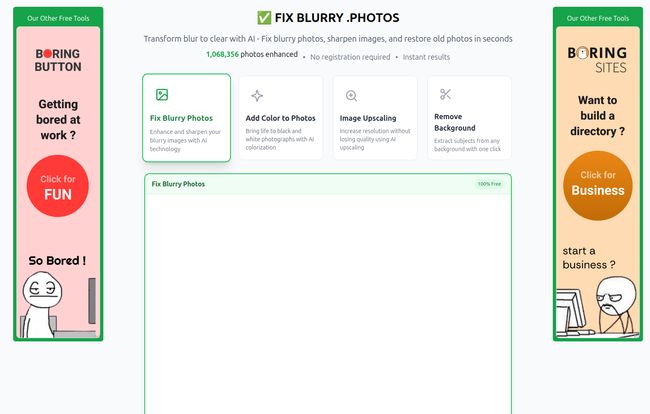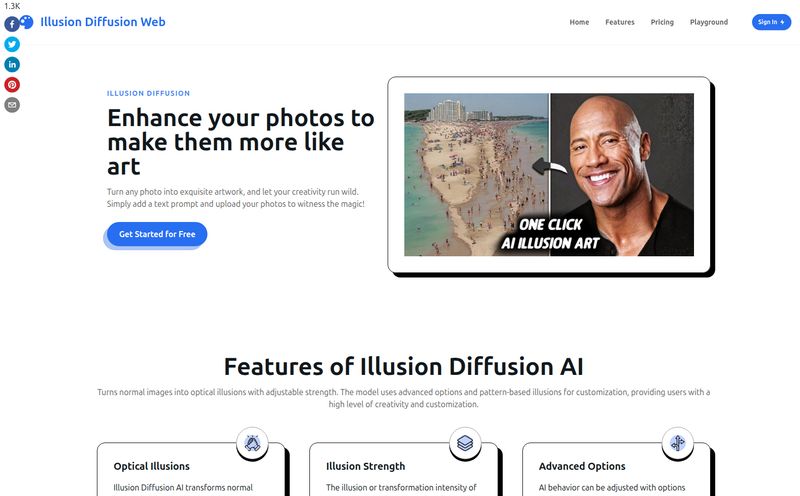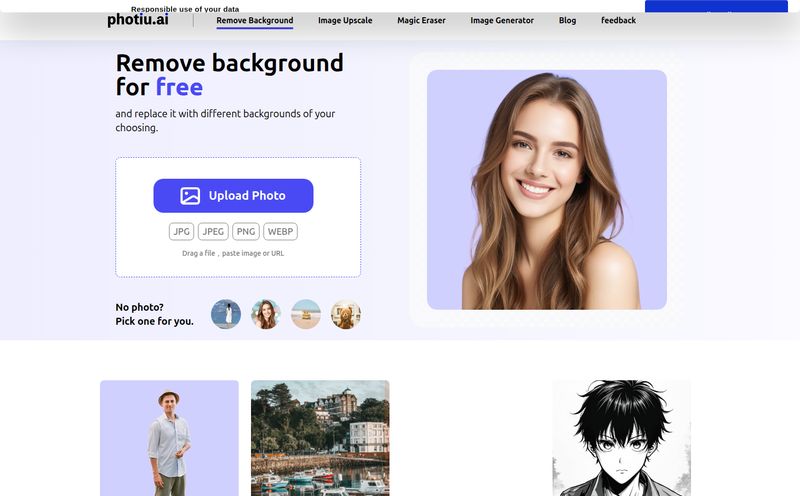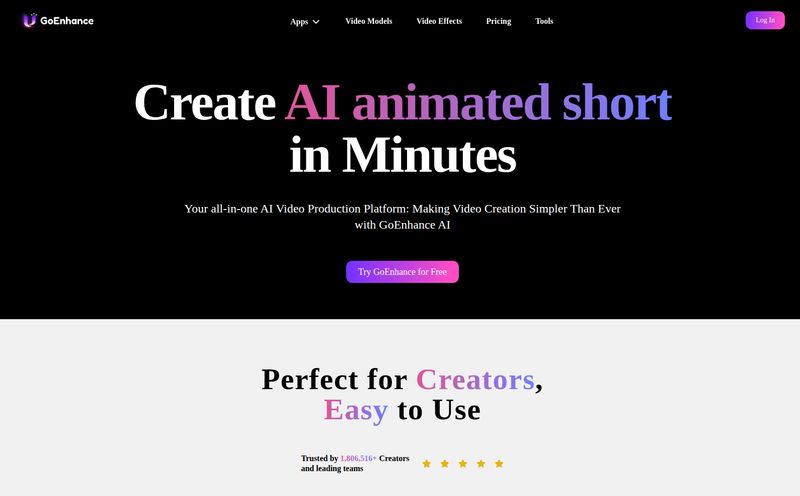We all have them. That digital shoebox stuffed with photos from the early 2000s, captured on a camera that probably had fewer megapixels than a modern-day toaster. Or even better, the actual shoebox in your parents’ attic, filled with faded, cracked photographs of relatives you barely recognize. They’re precious memories, but they look… well, they look like they’ve been through a war.
For years, fixing these images meant either spending hours wrestling with complex software like Photoshop or paying a professional restorer a small fortune. As an SEO guy, I know how critical clear visuals are for engagement, but I’m also a sucker for a good, free tool that does the heavy lifting for me. So when I stumbled upon Fixblurry.photos, my curiosity was definitely piqued.
The site claims to be a completely free, AI-powered service to fix blurry and damaged photos. No strings, no registration, no watermarks. My inner skeptic immediately flared up. Free? In this economy? There's gotta be a catch. So, I decided to put it through its paces.
So, What Exactly is Fixblurry.photos?
At its heart, Fixblurry.photos is a one-trick pony, and I mean that in the best way possible. It’s designed to do one thing and do it incredibly well: take your blurry, old, or slightly mangled photos and make them sharp and clear again. It uses artificial intelligence to analyze the image, identify issues like motion blur or focus problems, and then intelligently reconstruct the details.
Think of it like digital CPR for your old pictures. It’s for anyone who has a cherished photo that’s just a little too fuzzy, a scanned image that’s lost its pop, or a portrait where the faces are just not quite in focus. And did I mention its free?

Visit Fixblurry.photos
First Impressions: A Breath of Fresh Air
The first thing that struck me when I landed on the homepage was its beautiful simplicity. There are no confusing menus, no endless pop-ups demanding your email, no jargon-filled feature lists. There is just a single, clean box that says, “Drag blurry photos here.”
That’s it. That’s the entire user interface.
In a world where every “free” service wants you to sign up for a newsletter, create an account, and offer up your firstborn child, this was unbelievably refreshing. You just drop your photo in and the AI gets to work. No registration required. This immediately lowers the barrier to entry to basically zero. You can try it out in literally ten seconds with no commitment. I love that.
Putting the AI to the Test: From Faded to Fabulous
A simple interface is nice, but it's the results that matter. I dug up a few photographic culprits from my own collection to see what this tool was really made of.
Challenge 1: The Ancestor Photograph
First up was a scanned photo of my great-grandfather. It’s a classic—sepia-toned, a bit faded, and the focus is just soft enough that his features are indistinct. I uploaded the JPG, and within about five seconds, a slider appeared showing a “before” and “after.”
And I have to say, I was genuinely surprised. The AI didn’t just generically sharpen the whole image. It seemed to recognize the face and selectively enhanced the details. His eyes were clearer, the texture of his suit jacket was more defined, and the overall softness was gone. It didn’t look artificially sharp or over-processed; it just looked… better. Like a memory brought into focus. It even seemed to subtly balance the colors, making the faded sepia tones feel a little richer.
Challenge 2: The 'Potato-Quality' Concert Shot
Next, I tried something more modern. A low-light photo I took at a concert a few years back with an old phone. It was a noisy, blurry mess—a classic “potato-quality” image. This is where I expected the tool to fail. These kinds of photos are notoriously hard to fix because there's so little data for an AI to work with.
The result? It was a definite improvement. The AI managed to reduce a lot of the grainy noise and significantly sharpened the performers on stage. Was it a crystal-clear, professional shot now? Of course not. An AI can’t invent detail that was never there to begin with. But it transformed the picture from an unusable smudge into something I’d actually consider posting. It even features an upscaler, which helps give these low-res shots a bit more heft so they don’t look so pixelated on a larger screen.
Challenge 3: The Slightly Out-of-Focus Portrait
Finally, a modern portrait where the camera just missed the focus on the eyes. We’ve all been there. It’s a great shot otherwise, but that slight blur makes it unusable. The platform specifically mentions a “Face Photo Restorer,” so I was keen to test this. The tool absolutely nailed it. It sharpened the eyes and eyelashes, defined the hairline, and made the whole face pop without affecting the soft-focus background. It was less like a sledgehammer and more like a precision tool.
How Does This AI Magic Actually Work?
According to the site's own FAQ, the AI has been trained on millions of image pairs. This is a common technique in machine learning. Essentially, the developers feed the AI a blurry photo and then show it the corresponding sharp, clear version. Over and over and over again. After analyzing millions of examples, the AI learns the patterns of what blur looks like and, more importantly, how to reverse it.
It’s not so different from how a human artist learns. They study thousands of faces to understand anatomy before they can paint a realistic portrait from memory. This AI has studied thousands of blurry photos to understand how to restore them. Pretty neat stuff.
The Big Question: So What's the Catch?
This is the part where I usually find the hidden subscription fee or the sneaky limitations. But with Fixblurry.photos, the catch is... there really isn't much of one.
- It's genuinely free. I processed several photos and was never asked for money.
- No watermarks. The downloaded images are clean. This is a huge deal, as most free competitors slap a big, ugly watermark on your picture.
- Commercial use is allowed. Their terms of service state you can use the restored photos for both personal and commercial projects. As a content creator, that's a massive green light.
So, what are the downsides? Well, no tool is perfect. The main limitation is that its effectiveness depends on the source image. For photos with mild to moderate blur, it works wonders. But if you feed it a photo that's a complete, unrecognizable blur or severely damaged with huge chunks missing, it's not going to perform a miracle. It can only enhance what's already there.
The other thing is the lack of control. This is a double-edged sword. Its one-click simplicity is its greatest strength, but it's also a weakness for power users. You can’t adjust the intensity of the sharpening or tweak the color correction. You get what the AI gives you. For 95% of people, that’s perfectly fine. For a professional photo retoucher, they’ll still want the granular control of their expensive software.
Who Should Use This Tool? (And Who Shouldn't)
After playing around with it for a while, I have a pretty clear idea of who this is for.
This tool is perfect for:
- Everyday People: Anyone wanting to rescue old family photos from digital decay.
- Social Media Users: If you need to quickly sharpen up a profile picture or a photo for your feed.
- Bloggers and Content Creators: A fantastic resource for improving blog post images or visuals without a budget for software.
- Students and Hobbyists: People who need a quick fix without the steep learning curve of professional tools.
This tool is probably not for:
- Professional Photographers/Retouchers: They’ll need more control and higher-resolution outputs than a simple online tool can provide.
- Archivists: For museum-quality restoration, you still need a human expert with specialized equipment.
Frequently Asked Questions
Is it really 100% free to use?
Yep. I kept waiting for a paywall to pop up, but it never did. It’s completely free to use, and they don’t even put a watermark on your final image, which is pretty amazing.
What about my privacy? Are my photos safe?
According to their privacy policy, they don't store your photos permanently. They are uploaded for processing and then removed. This is a pretty standard and responsible approach for a tool like this.
Can I use this on my phone?
Absolutely. The website works directly in your mobile browser. I tried it on my iPhone, and it was just as easy as on my desktop. You just upload a photo from your camera roll, and it works the same way.
What file types does it support?
It handles the most common ones you'd expect: JPG, PNG, and WEBP. Pretty much any standard picture you have will work just fine.
Will it work on every single blurry photo?
It's great, but it's not a miracle worker. It does its best work on photos with mild to moderate blur. If the image is extremely blurry to the point where the subject is just a blob, the AI might struggle to figure out what it's even looking at.
My Final Verdict on Fixblurry.photos
In the crowded space of online tools, it’s rare to find something that is simple, effective, and truly free. Fixblurry.photos is one of those rare finds. It’s a wonderfully accessible tool that solves a very common problem. It democratizes photo restoration, taking it out of the hands of experts with expensive software and giving it to anyone with an internet connection.
It won't replace a professional for high-stakes archival work, but for bringing a little life back to your old family albums or sharpening up a social media post, it's an absolute gem. I’ve already bookmarked it, and I have a feeling I’ll be using it a lot. Give it a shot—what have you got to lose, except a bit of blur?
References and Sources
- Fixblurry.photos Homepage: https://fixblurry.photos/
- Terms of Service: https://fixblurry.photos/terms-of-use



